Pelagic birding in Lima
For once we had great sunshine on the pelagic in July. That is very unusual.
Chilean Skua
South Polar Skua
Band-tailed Gull
Salvin’s Albatross
South American Tern

For once we had great sunshine on the pelagic in July. That is very unusual.

On November 26, 2007, I took a series of photos of the coots at Pantanos de Villa. The variation is extreme and I suspect there may be genes in the population from other species. The question is which species?
The background is the strange coot I found at Pantanos de Villa on OCt 15, 2005 which has many traits of Red-gartered Coot Fulica armillata.
STRANGE COOTS IN VILLA

In 2005 on a pelagic in July from Lima a dark gray bellied breeding plumage Sterna Tern was seen that was tentatively identified as Antarctic Tern, which would be a first for Peru. This one looks quite like the one we saw then, though I recall the bill was shorter than this. The posterior discussion on Birding Peru Yahoo-group confirmed this bird as South American Tern.
Short-tailed Shearwater? Unfortunately not. Scrutinizing the pictures and with comments from Birding Peru yahoo group it is noted that the dark black wedge from the “arm-pit” is a good field mark for Sooty Shearwater.
Northern Giant Petrel was recorded for the first time in Peru in 2002 on a Kolibri Expeditions pelagic. It is now a regular on our pelagics of July to September. This is the first time we found a bird that is not completely brown. Can this one be aged?
.
Join us on next full day pelagic Nov 17…or on our regular daily whale-watching excursion between November to March.

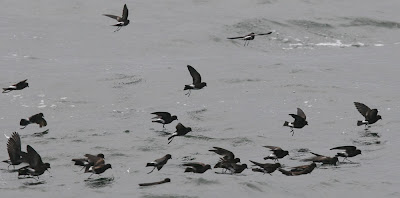
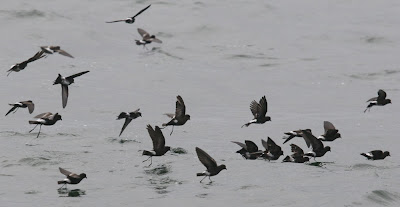
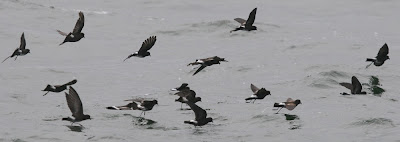
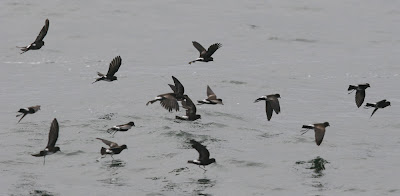
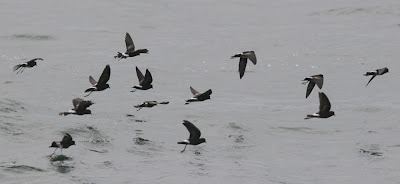
I hope someone can forward some discussion on the molt in Wilson‘s and White–vented SP.

Last also a Salvin‘s Albatross seen quite well on this occation. Also in a bit of molt..

Done a few more trips to search for Cetaceans and seabirds the last two months.
On January 19 a full day at sea gave many fantastic observations of Dolphins and one whale.

This may be a Sei whale that has lost its dorsal fin.
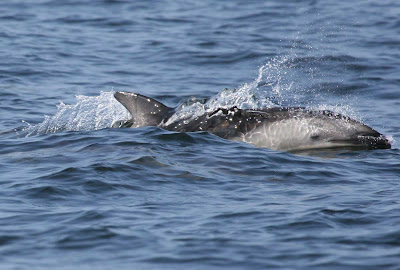
Dusky Dolphins come close to the boat.
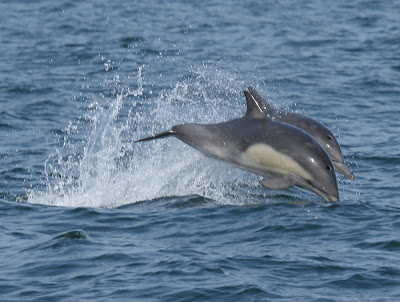
Common Dolphins were also often seen on this full day trip.
On February 18 we had great observations of a Bryde’s/Sei Whale. 
On February 23 we saw large numbers of Dusky Dolphins. The Inca Terns and Peruvian Boobies follow the moving schools of hunting dolphins is an good way to detect dolphin activity.

Recently Kolibri Expeditions started more specialized whale and dolphin safaris from Callao. We have since 2000 arranged full day pelagic trips to look for birds and during these trips we have often encountered Cetaceans (whales and doplhins collectively). However, 11-12 hours at sea is a bit too much for those that have the chief interest in watching mammals. Therefore since November 2006 we are arranging these shorter 5 hours trips with a speed boat.

However, details about the ocurance of other whales in other seasons are still very little known. It is hoped, with these five hours trips on a regular basis, on which we will record position, numbers, species and activities of all cetaceans, that we will learn more about the movements of cetaceans off the coast of Callao.
During the month of January, we have seen many other cetaceans in the past including Sei, Fin and Bryde’s Whale – and the usual three species of dolphins (Common, Bottle-nosed and Dusky Dolphins). During January we be operating 5 hours whale and dolphin watching trips on January 6 and 14. On January 19 there will be a full day pelagic for birdwatchers, but the chance of seeing whales and dolphins on this trip is also a very good since we cover much more ground.
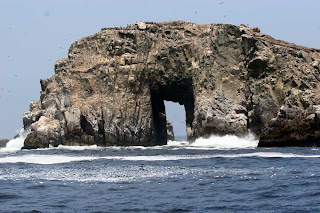 On Nov 30, 2006 we made our last trip.
On Nov 30, 2006 we made our last trip.
Once again, we went out to sea trying to spot cetaceans. It was a fine day with good views. The cloud cover soon broke up and we saw the sun. Passing the guano Palomino island of Island we continue straigth out into the deep ocean.


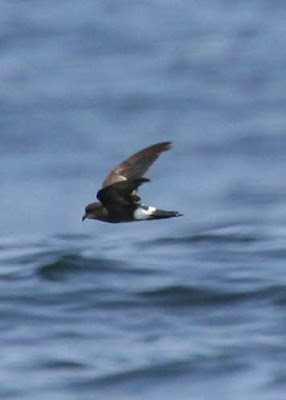
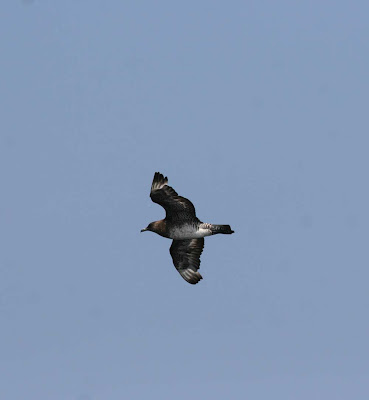
There were many Pomerine Jaegers about. They are the true pirates of the sea, chasing after other birds, bothering them in all ways possible like grabbing their feathers, untill the victim has to give up that recently caught anchoveta.
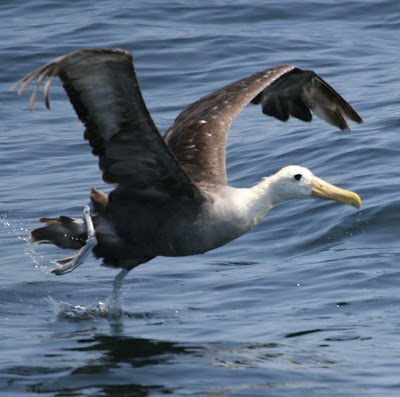
 Española than some 10 years ago. Apparantly adult mortality away from the colony is very high, so that the species should warrent critical threatened status. It seems that bycatch and intentional killing in Northern Peru is the big problem. See the BirdLife Internationals ongoing discussion about this species.
Española than some 10 years ago. Apparantly adult mortality away from the colony is very high, so that the species should warrent critical threatened status. It seems that bycatch and intentional killing in Northern Peru is the big problem. See the BirdLife Internationals ongoing discussion about this species. Back at Isla Palomino we encountered the huge sealion colony. In spite of being in the middle of the day there were surely more than 1000 individuals. In the late afternoon one can see between 5000-8000 sealions here.
Back at Isla Palomino we encountered the huge sealion colony. In spite of being in the middle of the day there were surely more than 1000 individuals. In the late afternoon one can see between 5000-8000 sealions here.Gunnar Engblom
Kolibri Expeditions
Birding Peru with Kolibri Expeditions
More Birds!

Who would believe that there are condors only 3 hours from noisy metropolis Lima? Well it is true. Here in Santa Eulalia Canyon, we found on Dec 16, 2006 around 12 condors, close to the village of Huachupampa.

It is quite clear that the steep cliffs make an excellent overnight colony for the condors. Here they can easily find the thermal winds that will ascend them high enough to scan over the area of Santa Eulalia river and over the ridge to the Rimac river.
 We know for a fact that there are at least 3-4 overnight cliffs in the canyon so there may be up to 50 condors in the whole area. And in difference from many other areas in Peru, they are doing well here. How do we know? Well, by establishing the ratio adults/juveniles one gets a good idea. When the ratio is >1 or more (more adults than young), the reproduction rate is low or the mortality of young is high and the population is therefore decreasing. When the ratio is 1 the population is more or less stable. When it is less than one (more young than adults) the conditions are either excellent and the population is increasing – or in some cases it can be a sign of adult mortality – but the latter would show in low overall numbers. In Santa Eulalia Canyon the population is certainly increasing. Of the 12 individuals we saw only 3 were adults.
We know for a fact that there are at least 3-4 overnight cliffs in the canyon so there may be up to 50 condors in the whole area. And in difference from many other areas in Peru, they are doing well here. How do we know? Well, by establishing the ratio adults/juveniles one gets a good idea. When the ratio is >1 or more (more adults than young), the reproduction rate is low or the mortality of young is high and the population is therefore decreasing. When the ratio is 1 the population is more or less stable. When it is less than one (more young than adults) the conditions are either excellent and the population is increasing – or in some cases it can be a sign of adult mortality – but the latter would show in low overall numbers. In Santa Eulalia Canyon the population is certainly increasing. Of the 12 individuals we saw only 3 were adults.
The two individuals on the above photo are young birds
 That this area has very good wildlife is indicated by the finding on our excursion of this cat. It is a Pampas Cat Leopardus pajeros. (Thanks to Javier Barrio and Eduardo Ormaeche for pointing in the right direction to its identity.)
That this area has very good wildlife is indicated by the finding on our excursion of this cat. It is a Pampas Cat Leopardus pajeros. (Thanks to Javier Barrio and Eduardo Ormaeche for pointing in the right direction to its identity.)
 Kolibri Expeditions has started a project of condor and wildlife watching in Santa Eulalia Canyon.
Kolibri Expeditions has started a project of condor and wildlife watching in Santa Eulalia Canyon.
San Pedro de Casta village
Santa Eulalia Canyon is not as famous as Colca, but it has very dramatic features. The drop in this picture is well over 1000m.
In 1995-96 when tourism to Peru started recovering around 8-10.000 people made the ardeous 10 hour trip to Chivay in Colca Canyon suffering from a dusty and bumpy road and a pass of over 5000m. In Chivay they stayed overnight at 3700m in basic hotels. Cold to the bones and altitude sickness for sure. Next day they had still a 2 hour trip on an even worse road to Cruz del Condor. But condors were almost 100% certain – and at close range. I personally doubt very much that anyone would have past through all that suffering if it was not for the guaranteed views of condors
In 10 years infrastructure has improved. Now there are first class hotels and part of the road has been sealed. Over 130.000 people visited Colca Canyon in 2006. You ask anyone in Peru, where one should see condors and they will send you to Colca Canyon. Now, one can hope for a development in Santa Eulalia Canyon similar to that of Colca. With eco-tourism the condor population in Peru could thrive and it could bring a very welcome income to the forgotten valleys along the Peruvian Andes
Please contact kolibriexp@gmail.com if you want to join us on a general natural history tour to watch for condores. This tour can be arranged at any time. The cost including transport, lodging and all food is only 99 US$/person – with a minimum of 4 people.
